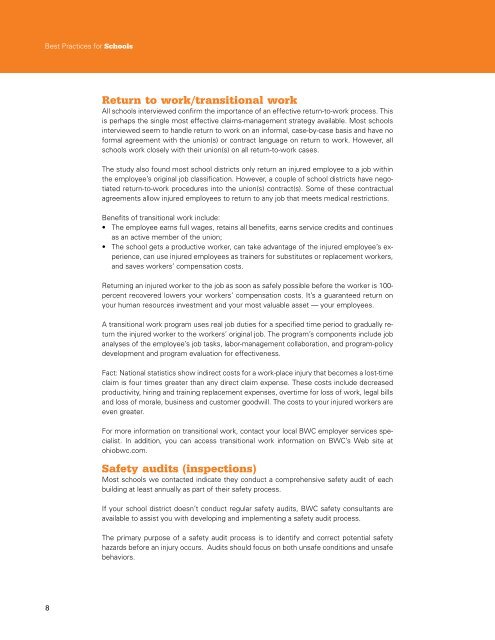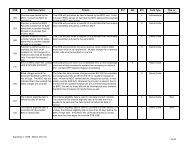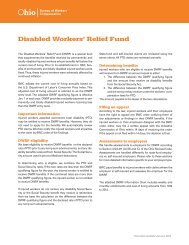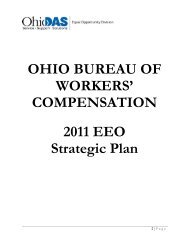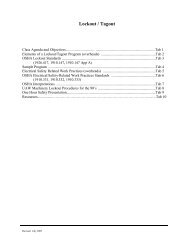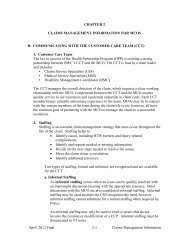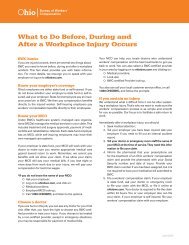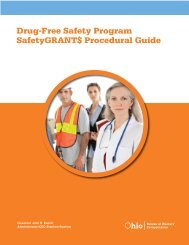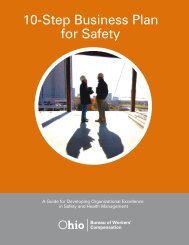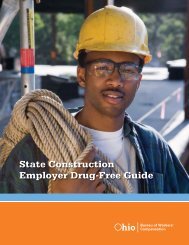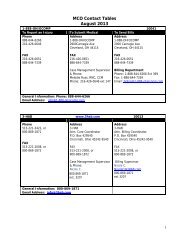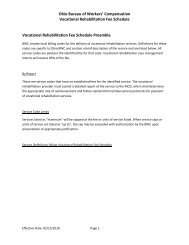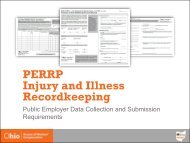Best Practices for Schools - Ohio Bureau of Workers' Compensation
Best Practices for Schools - Ohio Bureau of Workers' Compensation
Best Practices for Schools - Ohio Bureau of Workers' Compensation
You also want an ePaper? Increase the reach of your titles
YUMPU automatically turns print PDFs into web optimized ePapers that Google loves.
<strong>Best</strong> <strong>Practices</strong> <strong>for</strong> <strong>Schools</strong><br />
Return to work/transitional work<br />
All schools interviewed confirm the importance <strong>of</strong> an effective return-to-work process. This<br />
is perhaps the single most effective claims-management strategy available. Most schools<br />
interviewed seem to handle return to work on an in<strong>for</strong>mal, case-by-case basis and have no<br />
<strong>for</strong>mal agreement with the union(s) or contract language on return to work. However, all<br />
schools work closely with their union(s) on all return-to-work cases.<br />
The study also found most school districts only return an injured employee to a job within<br />
the employee’s original job classification. However, a couple <strong>of</strong> school districts have negotiated<br />
return-to-work procedures into the union(s) contract(s). Some <strong>of</strong> these contractual<br />
agreements allow injured employees to return to any job that meets medical restrictions.<br />
Benefits <strong>of</strong> transitional work include:<br />
• The employee earns full wages, retains all benefits, earns service credits and continues<br />
as an active member <strong>of</strong> the union;<br />
• The school gets a productive worker, can take advantage <strong>of</strong> the injured employee’s experience,<br />
can use injured employees as trainers <strong>for</strong> substitutes or replacement workers,<br />
and saves workers’ compensation costs.<br />
Returning an injured worker to the job as soon as safely possible be<strong>for</strong>e the worker is 100-<br />
percent recovered lowers your workers’ compensation costs. It’s a guaranteed return on<br />
your human resources investment and your most valuable asset — your employees.<br />
A transitional work program uses real job duties <strong>for</strong> a specified time period to gradually return<br />
the injured worker to the workers’ original job. The program’s components include job<br />
analyses <strong>of</strong> the employee’s job tasks, labor-management collaboration, and program-policy<br />
development and program evaluation <strong>for</strong> effectiveness.<br />
Fact: National statistics show indirect costs <strong>for</strong> a work-place injury that becomes a lost-time<br />
claim is four times greater than any direct claim expense. These costs include decreased<br />
productivity, hiring and training replacement expenses, overtime <strong>for</strong> loss <strong>of</strong> work, legal bills<br />
and loss <strong>of</strong> morale, business and customer goodwill. The costs to your injured workers are<br />
even greater.<br />
For more in<strong>for</strong>mation on transitional work, contact your local BWC employer services specialist.<br />
In addition, you can access transitional work in<strong>for</strong>mation on BWC’s Web site at<br />
ohiobwc.com.<br />
Safety audits (inspections)<br />
Most schools we contacted indicate they conduct a comprehensive safety audit <strong>of</strong> each<br />
building at least annually as part <strong>of</strong> their safety process.<br />
If your school district doesn’t conduct regular safety audits, BWC safety consultants are<br />
available to assist you with developing and implementing a safety audit process.<br />
The primary purpose <strong>of</strong> a safety audit process is to identify and correct potential safety<br />
hazards be<strong>for</strong>e an injury occurs. Audits should focus on both unsafe conditions and unsafe<br />
behaviors.


